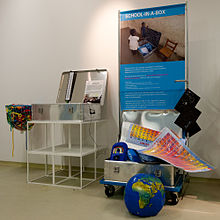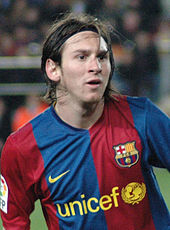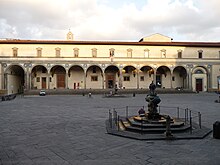UNICEF: Difference between revisions
Undid revision 544111657 by Marvismarvis (talk) |
|||
| Line 124: | Line 124: | ||
*[[Alliance for Healthy Cities]] |
*[[Alliance for Healthy Cities]] |
||
*[[Awaaz do|Awaaz do – India]] |
*[[Awaaz do|Awaaz do – India]] |
||
*[http://www.assar.asia Advance Studies on Social & Administrative Reforms] [[ASSAR]] of Asia |
|||
*[[Cartoons for Children's Rights]] |
*[[Cartoons for Children's Rights]] |
||
*[[Facts for Life]] |
*[[Facts for Life]] |
||
Revision as of 09:36, 25 March 2013
| File:Unicef logo.svg UNICEF Logo | |
| Established | December 1946 |
|---|---|
| Type | Fund |
| Legal status | Active |
| Headquarters | New York, USA |
Revenue | $3,372,540,239 [1] |
| Website | UNICEF official site |


The United Nations Children's Fund (UNICEF; /[invalid input: 'icon']ˈuːn[invalid input: 'ɨ']sɛf/ YEW-ni-sef)[2] is a United Nations Programme headquartered in New York City, that provides long-term humanitarian and developmental assistance to children and mothers in developing countries. It is one of the members of the United Nations Development Group and its Executive Committee.[3]
UNICEF was created by the United Nations General Assembly on December 11, 1946, to provide emergency food and healthcare to children in countries that had been devastated by World War II. In 1954, UNICEF became a permanent part of the United Nations System and its name was shortened from the original United Nations International Children's Emergency Fund but it has continued to be known by the popular acronym based on this old name.
UNICEF relies on contributions from governments and private donors and UNICEF's total income for 2008 was $3,372,540,239.[1] Governments contribute two thirds of the organization's resources; private groups and some 6 million individuals contribute the rest through the National Committees. It is estimated that 91.8% of their revenue is distributed to Program Services.[4] UNICEF's programs emphasize developing community-level services to promote the health and well-being of children. UNICEF was awarded the Nobel Peace Prize in 1965 and the Prince of Asturias Award of Concord in 2006.
Most of UNICEF's work is in the field, with staff in over 190 countries and territories. More than 200 country offices carry out UNICEF's mission through a program developed with host governments. Seventeen regional offices provide technical assistance to country offices as needed.
Overall management and administration of the organization takes place at its headquarters in New York. UNICEF's Supply Division is based in Copenhagen and serves as the primary point of distribution for such essential items as vaccines, antiretroviral medicines for children and mothers with HIV, nutritional supplements, emergency shelters, educational supplies, among others. A 36-member Executive Board establishes policies, approves programs and oversees administrative and financial plans. The Executive Board is made up of government representatives who are elected by the United Nations Economic and Social Council, usually for three-year terms.
Following the reaching of term limits by Executive Director of UNICEF Carol Bellamy, former United States Secretary of Agriculture Ann Veneman became executive director of the organization in May 2005, with an agenda to increase the organization's focus on the Millennium Development Goals. She was succeeded in May 2010, by Anthony Lake.
UNICEF is an intergovernmental organization (IGO) and thus is accountable to those governments. UNICEF’s salary and benefits package[5] is based on the United Nations Common System.
UNICEF National Committees
There are National Committees in 36 [industrialized] countries worldwide, each established as an independent local non-governmental organization. The National Committees raise funds from the private sector.
UNICEF is funded exclusively by voluntary contributions, and the National Committee collectively raise around one-third of UNICEF's annual income. This comes through contributions from corporations, civil society organizations and more than 6 million individual donors worldwide. They also rally many different partners – including the media, national and local government officials, NGOs, specialists such as doctors and lawyers, corporations, schools, young people and the general public – on issues related to children’s rights
(see List of UNICEF National Committees) United Nations International Children s Emergency Fund
Promotion and fundraising
In the United States, Canada and some other countries, UNICEF is known for its "Trick-Or-Treat for UNICEF" program in which children collect money for UNICEF from the houses they trick-or-treat on Halloween night, sometimes instead of candy.
UNICEF is present in 191 countries and territories around the world. UNICEF designated 1979 as the "Year of the Child" and many celebrities including David Gordon, David Essex, Alun Davies and Cat Stevens gave a performance at a benefit concert celebrating the Year of the Child Concert in December 1979.
Many people in developed countries first hear about UNICEF's work through the activities of 36 National Committees for UNICEF. These non-governmental organizations (NGO) are primarily responsible for fundraising, selling UNICEF greeting cards and products, creating private and public partnerships, advocating for children’s rights, and providing other invaluable support. The U.S. Fund for UNICEF is the oldest of the National Committees, founded in 1947.[6]
New Zealand appointed, in 2005, 18-year-old Hayley Westenra, a talented, world famous opera and pop singer as their Ambassador to UNICEF, in an effort to enlist the youth of the world in supporting UNICEF. Westenra has made several trips to visit underprivileged children in developing countries on behalf of UNICEF, in an effort to publicize their plight, and has engaged in fund-raising activities in support of the UNICEF mission.
On 19 April 2007, Grand Duchess Maria Teresa of Luxembourg was appointed UNICEF Eminent Advocate for Children,[7] in which role she has visited Brazil (2007),[8] China (2008),[9] and Burundi (2009).[10]
In 2009, the British retailer Tesco used “Change for Good” as advertising, which is trade marked by Unicef for charity usage but is not trademarked for commercial or retail use. This prompted the agency to say, "it is the first time in Unicef’s history that a commercial entity has purposely set out to capitalise on one of our campaigns and subsequently damage an income stream which several of our programmes for children are dependent on”. They went on to call on the public “who have children’s welfare at heart, to consider carefully who they support when making consumer choices”.[11] [12]
Sponsorship

On 7 September 2006, an agreement between UNICEF and the Spanish Catalan association football club FC Barcelona was reached whereby the club would donate 1.5 million euros per year to the organization for five years. As part of the agreement, FC Barcelona will wear the UNICEF logo on the front of their shirts, which will be the first time a football club sponsored an organization rather than the other way around. It is also the first time in FC Barcelona's history that they have had another organization's name across the front of their shirts.
In January 2007, UNICEF struck a partnership with Canada's national tent pegging team. The team was officially re-flagged as "UNICEF Team Canada", its riders wear UNICEF's logo in competition, and team members promote and raise funds for UNICEF's campaign against childhood HIV-AIDS.[13] When the team became the 2008 tent pegging world champions, UNICEF's flag was raised alongside the Canadian flag at the games, the first time in the history of international Grand Prix equestrian competition that a non-state flag has flown over the medal podium.[14]
The Swedish club Hammarby IF followed the Spanish and Canadian lead on 14 April 2007,[15] also raising funds for UNICEF and displaying the UNICEF name on their sportswear. The Danish soccer club Brondby IF will do likewise from the summer of 2008.
Australian A-League club Sydney FC announced they would also enter into a partnership with UNICEF raising funds for children in the Asia-Pacific region, and would also display the UNICEF logo for the remainder of the 2011-12 A-League season.[16]
Race driver Jacques Villeneuve has occasionally placed the UNICEF logo on the #27 Bill Davis Racing pickup truck in the NASCAR Craftsman Truck Series.
In Botswana, UNICEF has funded the development of new state-of-the-art HIV/AIDS education for every schoolchild in Botswana from nonprofit organization TeachAIDS.[17]
UNICEF recently announced a landmark partnership with Scottish club Rangers F.C. UNICEF will partner the Rangers Charity Foundation and have pledged to raise £300,000 by 2011.[18]
In 2010, UNICEF created a partnership with Phi Iota Alpha, making them the first Greek Lettered Organization UNICEF has ever worked with. In 2011, Phi Iota Alpha raised over $20,000 for the Tap Project and the Trick or Treats for UNICEF Campaign.
Trick-or-Treat UNICEF box
Since 1950, when a group of children in Philadelphia, Pennsylvania, donated $17 they received on Halloween to help post-World War II victims, the Trick-or-Treat UNICEF box has become a tradition in North America during the fall.[19] These small orange boxes are handed to children at schools and other locations (such as Hallmark Gold Crown Stores) before 31 October. To date, the Trick-or-Treat for UNICEF campaign has collected approximately $91 million (CAD) in Canada and over $167 million (USD) in the USA.[20]
Cartoons for Children's Rights
In 1994, UNICEF held a summit encouraging animation studios around the world to create individual animated spots demonstrating the international rights of children. Cartoons for Children's Rights is the collection of animated shorts based on UNICEF’s Convention on the Rights of the Child.
Corporate partnership
To raise money to support its Education and Literacy Programmes, UNICEF works together with companies all over the world – encompassing international as well as small- and medium-sized businesses. Since 2005, the organization has been supported by Montblanc, working colloabratively to help the world’s children getting better access to education.[citation needed]
Corporate Social Responsibility
UNICEF works directly with companies to improve their business practices, bringing them in line with obligations under international law, and ensuring that they respect children's rights in the realms of the marketplace, workplace and the community. In 2012, UNICEF worked with Save the Children and The UN Global Compact to develop the Children's Rights and Business Principles and now these guidelines form the basis UNICEF's advice to companies. UNICEF works with companies seeking to improve their social sustainability by guiding them through a due diligence process where issues throughout their supply chain, such as child labour, can be identified and actions to ratify them are put in place.[citation needed]
Facilities


UNICEF World Warehouse
The old UNICEF World Warehouse is a large facility in Denmark, which hosts UNICEF deliverable goods as well as co-hosts emergency goods for United Nations High Commissioner for Refugees (UNHCR) and the International Federation of Red Cross and Red Crescent Societies (IFRC). Until 2012 the housing facilities was a 25,000m2 warehouse at Marmormolen in Copenhagen. With construction of a 45,000m2 UN-city that is to house all UN activities in Copenhagen under one roof,[21] the warehouse service has been relocated to outer parts of Copenhagen Freeport. In addition to the goods, the facility houses the UNICEF Supply Division which manages strategic transport hubs in Dubai, Panama and Shanghai.[22] The warehouse contains a variety of items, e.g., special food supplies like the Plumpy'nut, water purification tablets, dietary and vitamin supplements, and the "School in a box" (illustrated above).
On 2 November 2011, Crown Prince Frederik and Crown Princess Mary of Denmark, with The Duke and Duchess of Cambridge, visited the warehouse[23] to highlight the crisis in East Africa.[24]
UNICEF Innocenti Research Centre
UNICEF Innocenti Research Centre in Florence, Italy, was established in 1988, to strengthen the research capability of the United Nations Children's Fund and to support its advocacy for children worldwide.
The centre, formally known as the International Child Development Centre, has as its prime objectives to improve international understanding of issues relating to children's rights, to promote economic policies that advance the cause of children, and to help facilitate the full implementation of the United Nations Convention on the Rights of the Child in industrialized and developing countries.
The programme for 2006–2008 was approved by UNICEF Executive Board in September 2005. It reaffirms the centre's academic freedom and the focus of IRC's research on knowledge gaps, emerging questions and sensitive issues which are relevant to the realization of children's rights, in developing and industrialized countries. It capitalizes on IRC's role as an interface between UNICEF field experience, international experts, research networks and policy makers and is designed to strengthen the centre's institutional collaboration with regional academic and policy institutions, pursuing the following goals:
- Generation and communication of strategic and influential knowledge on issues affecting children and the realization of their rights;
- Knowledge exchange and brokering;
- Support to UNICEF's advocacy, policy and programme development in support of the Millennium Agenda
- Securing and strengthening the centre's institutional and financial basis.
Three interrelated strategies will guide the achievement of these goals:
- Evidence-based analysis drawing on quantitative and qualitative information, the application of appropriate methodologies, and the development of recommendations to assess and inform advocacy and policy action.
- Enhanced partnerships with research and policy institutions and development actors, globally and at regional level, in developing and industrialized countries.
- Communication and leveraging of research findings and recommendations to support policy development and advocacy initiatives through strategic dissemination of studies and contribution to relevant events and fora.[25]
Criticism
UNICEF has been criticized at times for its focus or for specific policies. In 2004, the editorial in the Lancet argued that UNICEF's rights-based approach to child welfare, based upon the Convention on the Rights of the Child, whilst in accordance with international development policy, leads to a lower emphasis on child survival and mortality.[26]
One great concern is that the child mortality rate has not decreased in some areas and has actually increased. The highest rates were found in sub-Saharan Africa. This was difficult to understand, but even more concerning was that “over 60% of these deaths were and remain preventable.” (Horton, 2072) There was an estimated 19,000 children that died every day in 2011. It is important to recognize that “overall the least developed countries have consistently had higher rates of under-5 Mortality than more affluent countries.” (Currie, 1) Not only are these deaths preventable but the coverage levels for these interventions are “appallingly low in the 42 countries that account for 90% of child deaths.” (Horton, 2072)
See also
- Afghan New Beginnings Programme
- Alliance for Healthy Cities
- Awaaz do – India
- Advance Studies on Social & Administrative Reforms ASSAR of Asia
- Cartoons for Children's Rights
- Facts for Life
- Integrated Management of Childhood Illness
- List of UNICEF Goodwill Ambassadors
- Maurice Pate, first executive director of UNICEF
- Multiple Indicator Cluster Survey, statistical monitoring program of UNICEF
- Music for UNICEF Concert
- Street children
- Unite for Children, Unite Against AIDS
- Voices of Youth
References
- ^ a b UNICEF Annual Report 2008. unicef.org
- ^ "UNICEF", Dictionary.com Unabridged, retrieved 2009-06-04
- ^ Executive Committee. Undg.org. Retrieved on 2012-03-26.
- ^ Charity Navigator Rating – United States Fund for UNICEF. Charitynavigator.org. Retrieved on 2012-03-26.
- ^ United Nations Salaries, Allowances, Benefits and Job Classification. Un.org. Retrieved on 2012-03-26.
- ^ US Fund for UNICEF, unicefusa.org
- ^ Press centre – HRH Grand Duchess of Luxembourg becomes Eminent Advocate for Children. UNICEF. Retrieved on 2012-03-26.
- ^ Brazil – UNICEF Eminent Advocate for Children visits AIDS projects in São Paulo. UNICEF. Retrieved on 2012-03-26.
- ^ China – Summer camp aims to help children in China affected by AIDS. UNICEF. Retrieved on 2012-03-26.
- ^ Burundi – Grand Duchess Maria Teresa of Luxembourg visits Burundi. UNICEF. Retrieved on 2012-03-26.
- ^ Unicef accuses Tesco of misusing charity slogan. The Irish Times, Jul 25, 2009 (2009-07-07). Retrieved on 2012-03-26.
- ^ Tesco in clash with Unicef – Irish, Business. Independent.ie. July 26, 2009. Retrieved on 2012-03-26.
- ^ UNICEF Team Canada, maharaj.org
- ^ Newstrack India "International Tent Pegging", January 14, 2008
- ^ UNICEF, Hammarby strikes partnership, hammarbyfotboll.se Template:Sv icon
- ^ "Sydney FC and UNICEF do the rights things to improve child rights throughout Asia". UNICEF. 20 February 2012. Retrieved 24 February 2012.
- ^ "UNICEF funds TeachAIDS work in Botswana". TeachAIDS. 2 June 2010. Retrieved 16 December 2010.
- ^ "International Charity Partner – UNICEF". Rangers Charity Foundation. 10 September 2010. Retrieved 4 May 2011.
- ^ Smylie, James jH. (2001-01-01). "Presbyterians initiated UNICEF's 'Trick-or-Treat' program 50 years ago". The Presbyterian Outlook. Retrieved 2010-12-08.
{{cite web}}: Italic or bold markup not allowed in:|publisher=(help) - ^ "Trick-or-Treat for UNICEF". unicefusa.org. Retrieved 1 March 2013.
- ^ By & Havn. "FN Byen" (in Danish). Retrieved 2012-07-06.
- ^ UNICEF Supply and Logistics: Warehouse Operations
- ^ William and Kate in Denmark: Kate Middleton and Prince William join Crown Prince Frederik and Crown Princess Mary at UNICEF center in Copenhaagen. hellomagazine.com (2011-11-02). Retrieved on 2012-03-26.
- ^ BBC News – William and Kate in Unicef visit to Denmark aid centre. Bbc.co.uk (2011-11-02). Retrieved on 2012-03-26.
- ^ Innocenti Research Centre, UNICEF-irc.org
- ^ Horton, Richard (2004). "UNICEF leadership 2005–2015: a call for strategic change". The Lancet. 364 (9451): 2071–2074. doi:10.1016/S0140-6736(04)17560-0. PMID 15589292.
External links
This article's use of external links may not follow Wikipedia's policies or guidelines. (May 2012) |
- UNICEF
- UNICEF Cartoons for Children's Rights
- UNICEF Innocenti Research Centre
- UNICEF Mozambique
- United Nations Rule of Law: The United Nations Children's Fund, on the rule of law work conducted by the United Nations Children Fund.
- Intelligent Giving profile of UNICEF UK
- Unicef – Breastfeeding Support Forum
- UNICEF Goodwill Ambassador Femi Kuti speaks out against the suffering of Zimbabwean children
- UNICEF Child protection from violence, exploitation and abuse: Child labour
- UN Practitioner's Portal on HRBA Programming Resources on rights of the child, UN centralised webportal on the Human Rights-Based Approach to Development Programming.
- Ill-formatted IPAc-en transclusions
- Wikipedia external links cleanup from May 2012
- UNICEF
- Child-related organizations
- Children's charities
- International charities
- Recipients of the Indira Gandhi Peace Prize
- Organizations awarded Nobel Peace Prizes
- United Nations Development Group
- Organizations established by the United Nations
- Organizations established in 1946
- Organizations based in New York City
